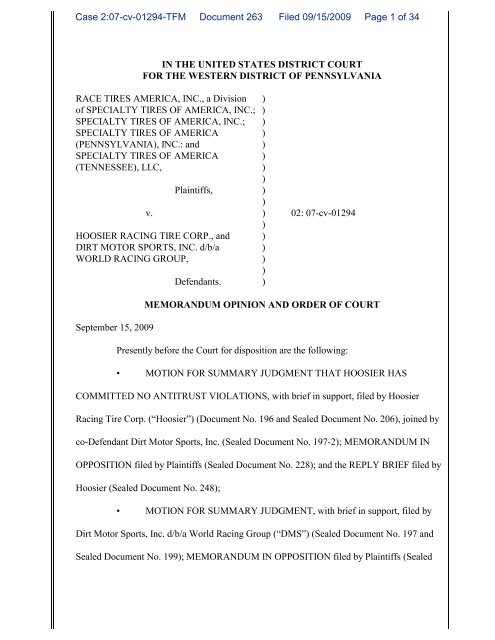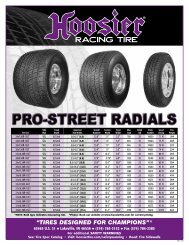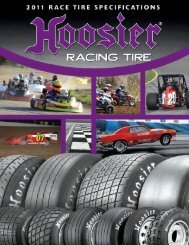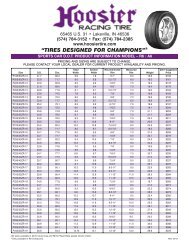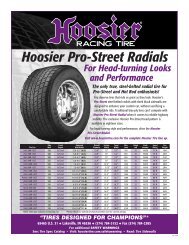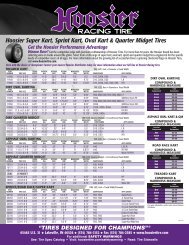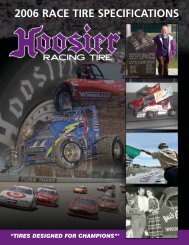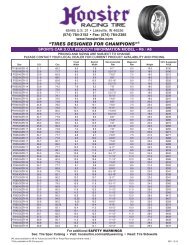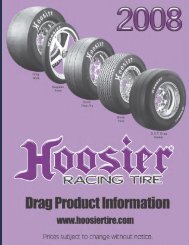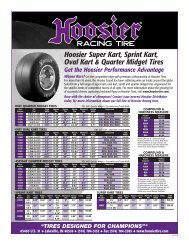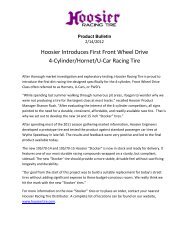in the united states district court for the - Hoosier Racing Tire
in the united states district court for the - Hoosier Racing Tire
in the united states district court for the - Hoosier Racing Tire
Create successful ePaper yourself
Turn your PDF publications into a flip-book with our unique Google optimized e-Paper software.
Case 2:07-cv-01294-TFM Document 263 Filed 09/15/2009 Page 1 of 34<br />
IN THE UNITED STATES DISTRICT COURT<br />
FOR THE WESTERN DISTRICT OF PENNSYLVANIA<br />
RACE TIRES AMERICA, INC., a Division )<br />
of SPECIALTY TIRES OF AMERICA, INC.; )<br />
SPECIALTY TIRES OF AMERICA, INC.; )<br />
SPECIALTY TIRES OF AMERICA )<br />
(PENNSYLVANIA), INC.: and )<br />
SPECIALTY TIRES OF AMERICA )<br />
(TENNESSEE), LLC, )<br />
)<br />
Pla<strong>in</strong>tiffs, )<br />
)<br />
v. ) 02: 07-cv-01294<br />
)<br />
HOOSIER RACING TIRE CORP., and )<br />
DIRT MOTOR SPORTS, INC. d/b/a )<br />
WORLD RACING GROUP, )<br />
)<br />
Defendants. )<br />
September 15, 2009<br />
MEMORANDUM OPINION AND ORDER OF COURT<br />
Presently be<strong>for</strong>e <strong>the</strong> Court <strong>for</strong> disposition are <strong>the</strong> follow<strong>in</strong>g:<br />
• MOTION FOR SUMMARY JUDGMENT THAT HOOSIER HAS<br />
COMMITTED NO ANTITRUST VIOLATIONS, with brief <strong>in</strong> support, filed by <strong>Hoosier</strong><br />
Rac<strong>in</strong>g <strong>Tire</strong> Corp. (“<strong>Hoosier</strong>”) (Document No. 196 and Sealed Document No. 206), jo<strong>in</strong>ed by<br />
co-Defendant Dirt Motor Sports, Inc. (Sealed Document No. 197-2); MEMORANDUM IN<br />
OPPOSITION filed by Pla<strong>in</strong>tiffs (Sealed Document No. 228); and <strong>the</strong> REPLY BRIEF filed by<br />
<strong>Hoosier</strong> (Sealed Document No. 248);<br />
• MOTION FOR SUMMARY JUDGMENT, with brief <strong>in</strong> support, filed by<br />
Dirt Motor Sports, Inc. d/b/a World Rac<strong>in</strong>g Group (“DMS”) (Sealed Document No. 197 and<br />
Sealed Document No. 199); MEMORANDUM IN OPPOSITION filed by Pla<strong>in</strong>tiffs (Sealed
Case 2:07-cv-01294-TFM Document 263 Filed 09/15/2009 Page 2 of 34<br />
Document No. 227); and REPLY MEMORANDUM filed by DMS (Sealed Document No.<br />
251); and<br />
• MOTION FOR PARTIAL SUMMARY JUDGMENT, with brief <strong>in</strong> support,<br />
filed by Pla<strong>in</strong>tiffs (Sealed Document Nos. 202 and 204); BRIEF IN OPPOSITION filed by<br />
<strong>Hoosier</strong> (Sealed Document No. 223); and MEMORANDUM OF LAW IN OPPOSITION filed<br />
by DMS (Sealed Document No. 224).<br />
The factual record has also been thoroughly developed via <strong>the</strong> CONCISE<br />
STATEMENT OF MATERIAL FACTS NOT IN DISPUTE filed by <strong>Hoosier</strong> (Sealed<br />
Document No. 207), PLAINTIFFS' RESPONSIVE CONCISE STATEMENT IN<br />
OPPOSITION TO MOTION FOR SUMMARY JUDGMENT FILED BY HOOSIER (Sealed<br />
Document No. 230), <strong>the</strong> CONCISE STATEMENT OF MATERIAL FACTS filed by DMS<br />
(Sealed Document No. 200), PLAINTIFFS’ RESPONSIVE CONCISE STATEMENT OF<br />
MATERIAL FACTS IN OPPOSITION TO MOTION FOR SUMMARY JUDGMENT FILED<br />
BY DMS (Sealed Document No. 229); <strong>the</strong> RESPONSE TO PLAINTIFFS’ “ADDITIONAL<br />
MATERIAL FACTS” filed by DMS (Sealed Document No. 250); <strong>the</strong> PLAINTIFFS’<br />
CONCISE STATEMENT OF MATERIAL FACTS IN SUPPORT OF THEIR MOTION FOR<br />
PARTIAL MOTION FOR SUMMARY JUDGMENT (Sealed Document No. 205); <strong>the</strong><br />
RESPONSIVE CONCISE STATEMENT TO “PLAINTIFFS’ CONCISE STATEMENT OF<br />
MATERIAL FACTS” filed by <strong>Hoosier</strong> (Sealed Document No. 221); PLAINTIFFS’ REPLY TO<br />
HOOSIER’S RESPONSIVE CONCISE STATEMENT (Sealed Document No. 245);<br />
RESPONSE TO PLAINTIFFS’ CONCISE STATEMENT OF MATERIAL FACTS filed by<br />
DMS (Sealed Document No. 225); and PLAINTIFFS’ REPLY TO DMS’ CONCISE<br />
2
Case 2:07-cv-01294-TFM Document 263 Filed 09/15/2009 Page 3 of 34<br />
STATEMENT OF MATERIAL FACTS (Sealed Document No. 244), as well as <strong>the</strong><br />
volum<strong>in</strong>ous exhibits submitted by all parties.<br />
On July 14, 2009, <strong>the</strong> Court heard oral argument on <strong>the</strong> motions. For purposes of <strong>the</strong><br />
oral argument and this Op<strong>in</strong>ion only, <strong>the</strong> motions <strong>for</strong> summary judgment filed by <strong>Hoosier</strong> and<br />
DMS were consolidated. All parties were represented by counsel who presented and argued <strong>the</strong><br />
issues skillfully and effectively. The matter is now ripe <strong>for</strong> disposition.<br />
After a careful consideration of <strong>the</strong> motions, <strong>the</strong> fil<strong>in</strong>gs <strong>in</strong> support and opposition<br />
<strong>the</strong>reto, <strong>the</strong> memoranda of <strong>the</strong> parties, <strong>the</strong> oral arguments of counsel, <strong>the</strong> relevant case law, and<br />
<strong>the</strong> record as a whole, <strong>the</strong> Motion <strong>for</strong> Summary Judgment filed by <strong>Hoosier</strong> will be granted, <strong>the</strong><br />
Motion <strong>for</strong> Summary Judgment filed by DMS will be granted, and <strong>the</strong> Motion <strong>for</strong> Partial<br />
Summary Judgment filed by Pla<strong>in</strong>tiffs will be denied as moot.<br />
Standard of Review<br />
Summary judgment should be granted “if <strong>the</strong> plead<strong>in</strong>gs, depositions, answers to<br />
<strong>in</strong>terrogatories, and admissions on file, toge<strong>the</strong>r with <strong>the</strong> affidavits, if any, show that <strong>the</strong>re is no<br />
genu<strong>in</strong>e issue as to any material fact and that <strong>the</strong> mov<strong>in</strong>g party is entitled to judgment as a<br />
matter of law.” Fed. R. Civ. P. 56(c). Thus, <strong>the</strong> Court's task is not to resolve disputed issues of<br />
fact, but to determ<strong>in</strong>e whe<strong>the</strong>r <strong>the</strong>re exist any factual issues to be tried. Anderson v. Liberty<br />
Lobby, Inc., 477 U.S. 242, 247-49 (1986). The non-mov<strong>in</strong>g party must raise “more than a mere<br />
sc<strong>in</strong>tilla of evidence <strong>in</strong> its favor” <strong>in</strong> order to overcome a summary judgment motion. Williams<br />
v. Borough of West Chester, 891 F.2d 458, 460 (3d Cir. 1989) (cit<strong>in</strong>g Liberty Lobby, 477 U.S.<br />
at 249). Fur<strong>the</strong>r, <strong>the</strong> non-mov<strong>in</strong>g party cannot rely on unsupported assertions, conclusory<br />
3
Case 2:07-cv-01294-TFM Document 263 Filed 09/15/2009 Page 4 of 34<br />
allegations, or mere suspicions <strong>in</strong> attempt<strong>in</strong>g to survive a summary judgment motion. Id.<br />
(cit<strong>in</strong>g Celotex Corp. v. Catrett, 477 U.S. 317, 325 (1986)). Distilled to its essence, <strong>the</strong><br />
summary judgment standard requires <strong>the</strong> non-mov<strong>in</strong>g party to create a “sufficient disagreement<br />
to require submission [of <strong>the</strong> evidence] to a jury.” Liberty Lobby, 477 U.S. at 251-52.<br />
Several <strong>court</strong>s have noted that summary disposition of antitrust cases is difficult<br />
because of <strong>the</strong>ir <strong>in</strong>herent factual complexity and because motive and <strong>in</strong>tent are paramount<br />
considerations. See e.g., Poller v. Columbia Broadcast<strong>in</strong>g Sys., Inc., 368 U.S. 464, 473 (1962).<br />
However, complexity does not mean that summary disposition is <strong>the</strong>reby precluded or even<br />
disfavored <strong>in</strong> antitrust law. Capital Imag<strong>in</strong>g Assoc., P.C. v. Mohawk Valley Medical Assoc.,<br />
Inc., 996 F.2d 537, 541 (2d Cir. 1993). Ra<strong>the</strong>r, summary judgment may be particularly<br />
important <strong>in</strong> antitrust cases to prevent lengthy and drawn-out litigation that has a chill<strong>in</strong>g effect<br />
on competitive market <strong>for</strong>ces. Id. The present motions will be considered <strong>in</strong> light of <strong>the</strong>se<br />
standards.<br />
Procedural Background<br />
Pla<strong>in</strong>tiffs, Race <strong>Tire</strong>s, Inc., a Division of Specialty <strong>Tire</strong>s of America, Inc., and<br />
Specialty <strong>Tire</strong>s of America Inc., <strong>in</strong>itiated this lawsuit on September 25, 2007, by <strong>the</strong> fil<strong>in</strong>g of a<br />
five-count Compla<strong>in</strong>t aga<strong>in</strong>st only one defendant, <strong>Hoosier</strong> Rac<strong>in</strong>g <strong>Tire</strong> Corp. (“<strong>Hoosier</strong>”).<br />
Pla<strong>in</strong>tiffs alleged Monopolization <strong>in</strong> violation of Section 2 of <strong>the</strong> Sherman Act (Count I),<br />
Conspiracy to Restra<strong>in</strong> Trade <strong>in</strong> violation of Section 1 of <strong>the</strong> Sherman Act (Count II),<br />
Attempted Monopolization <strong>in</strong> violation of Section 2 of <strong>the</strong> Sherman Act (Count III), Conspiracy<br />
4
Case 2:07-cv-01294-TFM Document 263 Filed 09/15/2009 Page 5 of 34<br />
to Monopolize (Count IV), and Request <strong>for</strong> A Declaratory Judgment pursuant to 28 U.S.C. §<br />
2201 (Count V).<br />
Less than a month later, on October 12, 2007, Pla<strong>in</strong>tiffs filed an Amended Compla<strong>in</strong>t<br />
<strong>in</strong> which <strong>the</strong>y named Dirt Motor Sports, Inc. d/b/a World Rac<strong>in</strong>g Group (“DMS”) as an<br />
additional defendant and <strong>in</strong>cluded allegations specific to DMS.<br />
On January 10, 2008, <strong>the</strong> Court entered a Case Management / Schedul<strong>in</strong>g Order<br />
which established a deadl<strong>in</strong>e of May 30, 2008, <strong>for</strong> amend<strong>in</strong>g of <strong>the</strong> plead<strong>in</strong>gs. The parties<br />
engaged <strong>in</strong> discovery, which resulted <strong>in</strong> a steady stream of disputed discovery motions be<strong>in</strong>g<br />
filed with <strong>the</strong> Court. At last count, <strong>the</strong> Court had ruled on at least ten (10) discovery motions.<br />
On March 13, 2008, Pla<strong>in</strong>tiffs filed a Second Amended Compla<strong>in</strong>t <strong>in</strong> which two<br />
“sister companies” of Specialty <strong>Tire</strong>s of America, Inc., were added as co-pla<strong>in</strong>tiffs: Specialty<br />
<strong>Tire</strong>s of America (Pennsylvania), Inc., and Specialty <strong>Tire</strong>s of America (Tennessee), LLC.<br />
On May 30, 2008, <strong>the</strong> actual deadl<strong>in</strong>e <strong>for</strong> seek<strong>in</strong>g leave to amend <strong>the</strong> plead<strong>in</strong>gs,<br />
Pla<strong>in</strong>tiffs moved to amend <strong>the</strong>ir compla<strong>in</strong>t a third time to add a new count which alleged a ty<strong>in</strong>g<br />
arrangement illegal under Section 1 of <strong>the</strong> Sherman Act. The Court granted Pla<strong>in</strong>tiffs’ request<br />
<strong>for</strong> leave and a Third Amended Compla<strong>in</strong>t was filed on June 23, 2008.<br />
On November 19, 2008, well after <strong>the</strong> expiration of <strong>the</strong> deadl<strong>in</strong>e <strong>for</strong> amend<strong>in</strong>g<br />
plead<strong>in</strong>gs, Pla<strong>in</strong>tiffs once aga<strong>in</strong> sought leave to amend <strong>the</strong>ir Compla<strong>in</strong>t to add a count alleg<strong>in</strong>g a<br />
concerted refusal to deal (group boycott). Not surpris<strong>in</strong>gly, Defendants strongly opposed<br />
Pla<strong>in</strong>tiffs’ request to amend <strong>the</strong>ir Compla<strong>in</strong>t a fourth time. On December 16, 2008, <strong>the</strong> Court<br />
denied <strong>the</strong> request to amend f<strong>in</strong>d<strong>in</strong>g that Pla<strong>in</strong>tiffs had failed to demonstrate good cause to<br />
amend and that it would be prejudicial to Defendants, fifteen months (15) months after <strong>the</strong><br />
5
Case 2:07-cv-01294-TFM Document 263 Filed 09/15/2009 Page 6 of 34<br />
lawsuit was <strong>in</strong>itiated and seven (7) months after <strong>the</strong> expiration of <strong>the</strong> deadl<strong>in</strong>e <strong>for</strong> seek<strong>in</strong>g leave<br />
to amend, to add a new claim based on an additional legal <strong>the</strong>ory, which would require<br />
additional written discovery and depositions. See Sealed Document No. 155.<br />
Background<br />
The history between <strong>the</strong> parties to this antitrust lawsuit is lengthy and contentious.<br />
The Court has noted on numerous occasions <strong>the</strong> considerable tension among <strong>the</strong> respective<br />
parties and <strong>the</strong>ir attorneys.<br />
Pla<strong>in</strong>tiffs, Race <strong>Tire</strong>s America, Inc., a Division of Speciality <strong>Tire</strong>s of America, Inc.;<br />
Speciality <strong>Tire</strong>s of America, Inc.; Specialty <strong>Tire</strong>s of America (Pennsylvania), Inc., and<br />
Speciality <strong>Tire</strong>s of America (Tennessee), LLC (collectively referred to as Pla<strong>in</strong>tiffs or “STA”)<br />
and <strong>Hoosier</strong> compete <strong>in</strong> sell<strong>in</strong>g rac<strong>in</strong>g tires used <strong>in</strong> auto rac<strong>in</strong>g events sponsored or promoted<br />
by DMS, and o<strong>the</strong>r sanction<strong>in</strong>g bodies, race track owners, promoters, and tour series.<br />
Competition between STA and <strong>Hoosier</strong> <strong>in</strong>cludes vy<strong>in</strong>g <strong>for</strong> s<strong>in</strong>gle tire rule contracts with<br />
sanction<strong>in</strong>g bodies.<br />
STA alleges that <strong>Hoosier</strong> has greater than a 70% market share <strong>in</strong> <strong>the</strong> dirt oval race<br />
track market, and an even greater market share <strong>in</strong> <strong>the</strong> market <strong>for</strong> <strong>the</strong> sale of race tires <strong>in</strong><br />
sanctioned dirt oval track races. Third Amended Compla<strong>in</strong>t, at 18. STA contends that<br />
<strong>Hoosier</strong> acquired and ma<strong>in</strong>ta<strong>in</strong>ed its monopoly power by enter<strong>in</strong>g <strong>in</strong>to anticompetitive<br />
exclusive deal<strong>in</strong>g agreements with sanction<strong>in</strong>g companies and with <strong>in</strong>dividual track owners /<br />
promoters.<br />
6
Case 2:07-cv-01294-TFM Document 263 Filed 09/15/2009 Page 7 of 34<br />
Pla<strong>in</strong>tiffs allege that sanction<strong>in</strong>g companies, <strong>in</strong> exchange <strong>for</strong> payments from <strong>Hoosier</strong>,<br />
have adopted and promulgated “<strong>Hoosier</strong>-only” tire(s) rules, pursuant to exclusive deal<strong>in</strong>g<br />
agreements with <strong>Hoosier</strong>. Accord<strong>in</strong>g to Pla<strong>in</strong>tiffs, <strong>the</strong>se <strong>Hoosier</strong>-only tire(s) rules <strong>for</strong>eclose<br />
competition <strong>in</strong> a substantial portion of each of <strong>the</strong> categories of cars that compete <strong>in</strong> dirt oval<br />
track rac<strong>in</strong>g. Pla<strong>in</strong>tiffs contend that <strong>the</strong>re is no legitimate bus<strong>in</strong>ess justification <strong>for</strong> <strong>the</strong><br />
exclusive <strong>Hoosier</strong>-only s<strong>in</strong>gle tire(s) rules.<br />
DMS is one of three major sanction<strong>in</strong>g companies <strong>in</strong> dirt oval track rac<strong>in</strong>g; <strong>the</strong> o<strong>the</strong>r<br />
two are International Motor Contest Association (“IMCA”) and WISSOTA Promotions, Inc.<br />
(“WISSOTA”). Accord<strong>in</strong>g to Pla<strong>in</strong>tiffs, <strong>the</strong>se three sanction<strong>in</strong>g companies sanction modified,<br />
late model, spr<strong>in</strong>t, or stock car races at over 70% of <strong>the</strong> 636 weekly tracks <strong>in</strong> <strong>the</strong> United States.<br />
Third Amended Compla<strong>in</strong>t, at 37. DMS sanctions over 5,000 races per year at over 200 dirt<br />
oval tracks <strong>in</strong> twenty-one (21) <strong>states</strong>; IMCA sanctions races at approximately 112 dirt oval<br />
tracks; and WISSOTA sanctions races at approximately 57 dirt oval tracks. Id. at 35-36.<br />
DMS is <strong>the</strong> only sanction<strong>in</strong>g company named as a defendant <strong>in</strong> this lawsuit.<br />
A. The Parties<br />
Pla<strong>in</strong>tiff Specialty <strong>Tire</strong>s of America, Inc. (“Speciality”) is a Pennsylvania corporation<br />
with its pr<strong>in</strong>cipal place of bus<strong>in</strong>ess and manufactur<strong>in</strong>g facility <strong>in</strong> Indiana, Pennsylvania.<br />
Pla<strong>in</strong>tiff Race <strong>Tire</strong>s America, Inc. (“RTA”) is a division of Specialty that designs, develops,<br />
markets and sells race tires which are manufactured by Speciality, Specialty <strong>Tire</strong>s of America<br />
(Pennsylvania) and Speciality <strong>Tire</strong>s of America (Tennessee) LLC. Pla<strong>in</strong>tiffs (collectively<br />
7
Case 2:07-cv-01294-TFM Document 263 Filed 09/15/2009 Page 8 of 34<br />
referred to as “STA”) are wholly-owned subsidiaries and part of <strong>the</strong> “tire division” of parent<br />
corporation Polymer Enterprises, Inc., a Delaware hold<strong>in</strong>g company.<br />
STA manufactures and sells speciality tires, <strong>in</strong>clud<strong>in</strong>g but not limited to, tires <strong>for</strong> use<br />
<strong>in</strong> light aircraft, <strong>in</strong>dustrial handl<strong>in</strong>g equipment, m<strong>in</strong><strong>in</strong>g equipment, farm and agriculture<br />
equipment, medium and heavy duty trucks, all terra<strong>in</strong> vehicles (“ATV”), light trucks, off <strong>the</strong><br />
road equipment, bias ply passenger tires, and <strong>the</strong> military.<br />
STA manufactures and sells its “house brand” rac<strong>in</strong>g tire known as <strong>the</strong> American<br />
Racer through its division RTA. American Racer tires <strong>in</strong>clude what STA denotes as dirt track<br />
rac<strong>in</strong>g and asphalt track rac<strong>in</strong>g tires, ATV rac<strong>in</strong>g tires, passenger per<strong>for</strong>mance tires, and race<br />
track equipment tires. STA also manufactures private label rac<strong>in</strong>g tires sold under <strong>the</strong> brand<br />
names Mickey Thomson, Burris, Morosso, Sand <strong>Tire</strong>s, Unlimited; and Malibu Grand Prix.<br />
Most of <strong>the</strong>se tires are not sold through STA’s RTA division.<br />
Defendant <strong>Hoosier</strong> is a family-owned bus<strong>in</strong>ess headquartered and located <strong>in</strong> Indiana.<br />
<strong>Hoosier</strong> focuses its bus<strong>in</strong>ess almost exclusively on sell<strong>in</strong>g rac<strong>in</strong>g tires. <strong>Hoosier</strong> tires are<br />
manufactured at a s<strong>in</strong>gle facility <strong>in</strong> Lakeville, Indiana, by its sister company, <strong>Hoosier</strong> <strong>Tire</strong> &<br />
Rubber Corp. <strong>Hoosier</strong> is <strong>the</strong> largest race tire manufacturer <strong>in</strong> <strong>the</strong> world that specializes <strong>in</strong><br />
manufactur<strong>in</strong>g rac<strong>in</strong>g tires.<br />
Defendant DMS is a motor sports sanction<strong>in</strong>g body and motor sports event company.<br />
DMS is a Delaware corporation with its pr<strong>in</strong>cipal place of bus<strong>in</strong>ess <strong>in</strong> Concord, North Carol<strong>in</strong>a.<br />
DMS operates race tracks and owns such rac<strong>in</strong>g tour<strong>in</strong>g series as <strong>the</strong> World of Outlaw Spr<strong>in</strong>t<br />
Car Series and Late Model Series. In 2005, DMS acquired United Midwest Promoters<br />
(“UMP”), ano<strong>the</strong>r sanction<strong>in</strong>g body. UMP sanctions late model tour<strong>in</strong>g series and races at<br />
8
Case 2:07-cv-01294-TFM Document 263 Filed 09/15/2009 Page 9 of 34<br />
tracks, as well as modified weekly rac<strong>in</strong>g. UMP had a “<strong>Hoosier</strong> only” rule <strong>for</strong> years, which has<br />
cont<strong>in</strong>ued under DMS’s ownership.<br />
B. Sanction<strong>in</strong>g Bodies <strong>in</strong> <strong>the</strong> Motor Sport Industry<br />
Most dirt oval tracks are owned or leased by owners / promoters, who own or lease<br />
<strong>the</strong> dirt oval tracks and organize and conduct <strong>the</strong> races. Most track owners / promoters are<br />
members of a “sanction<strong>in</strong>g body” <strong>for</strong> at least one class of cars at <strong>the</strong>ir track. A sanction<strong>in</strong>g<br />
body is an organization that <strong>for</strong>mulates and promulgates rules that govern <strong>the</strong> races which <strong>the</strong>y<br />
sanction. Sanction<strong>in</strong>g bodies compete to attract race car drivers (“drivers”) and fans to <strong>the</strong>ir<br />
races. In order to give <strong>the</strong> participants at its track <strong>the</strong> best opportunity to demonstrate <strong>the</strong>ir<br />
skills and encourage participation, a promoter or sanction<strong>in</strong>g body must provide a level play<strong>in</strong>g<br />
field <strong>for</strong> <strong>the</strong> competitors.<br />
The owners / promoters pay a sanction<strong>in</strong>g fee to <strong>the</strong> sanction<strong>in</strong>g body. It is desirable<br />
<strong>for</strong> track owners / promoters to be members of a sanction<strong>in</strong>g body because <strong>the</strong> sanction<strong>in</strong>g body<br />
creates <strong>in</strong>centives <strong>for</strong> drivers to drive <strong>in</strong> <strong>the</strong> races that <strong>the</strong>y sanction. These <strong>in</strong>centives <strong>in</strong>clude<br />
enabl<strong>in</strong>g drivers to accumulate po<strong>in</strong>ts, both nationally and regionally, race publicity, guarantee<br />
purses <strong>for</strong> <strong>the</strong> w<strong>in</strong>n<strong>in</strong>g drivers, and <strong>the</strong> promulgation of rules familiar to <strong>the</strong> race drivers.<br />
Sanction<strong>in</strong>g bodies often choose to utilize a “s<strong>in</strong>gle tire rule,” which requires that a<br />
specific tire type and brand be used on one or more wheel positions (i.e., right-and left-front,<br />
right-and left-rear) <strong>for</strong> one or more classes of cars <strong>for</strong> a series of races or rac<strong>in</strong>g seasons (e.g.,<br />
“spr<strong>in</strong>t cars,” “modifieds,” “hobby stocks,” “sports compacts”).<br />
9
Case 2:07-cv-01294-TFM Document 263 Filed 09/15/2009 Page 10 of 34<br />
Relevant to this lawsuit is <strong>the</strong> fact that sanction<strong>in</strong>g bodies generally do not buy tires<br />
<strong>the</strong>mselves, but ra<strong>the</strong>r establish <strong>the</strong> parameters of <strong>the</strong> type of tire that may be used <strong>in</strong> a race.<br />
Some rules may def<strong>in</strong>e <strong>the</strong> permissible tire by merely a bead size or o<strong>the</strong>r physical dimension;<br />
o<strong>the</strong>rs may require that <strong>the</strong> tires at one or more wheel locations be a particular type or brand of<br />
tire.<br />
<strong>Tire</strong> rules that do not require a specific brand of tire are called “open tire rules.”<br />
Among <strong>the</strong> many decisions sanction<strong>in</strong>g bodies make <strong>in</strong> promulgat<strong>in</strong>g <strong>the</strong>ir rules are whe<strong>the</strong>r a<br />
particular race should have an open tire rule or a s<strong>in</strong>gle tire rule (or some comb<strong>in</strong>ation <strong>the</strong>reof).<br />
For example, DMS has adopted a <strong>Hoosier</strong> tire rule <strong>for</strong> most of its race tracks and series, but<br />
DMS utilizes an “open tire rule” <strong>for</strong> some of its World of Outlaw races.<br />
A sanction<strong>in</strong>g company determ<strong>in</strong>es what tire rules to run <strong>for</strong> its various races and<br />
makes this decision based on its own self-<strong>in</strong>terest, <strong>in</strong>clud<strong>in</strong>g how best to market its races. A<br />
sanction<strong>in</strong>g body may decide that it wants a s<strong>in</strong>gle tire rule <strong>for</strong> all or most categories of its<br />
races.<br />
<strong>Tire</strong>s are not <strong>the</strong> only components of a race car subject to a s<strong>in</strong>gle source or<br />
manufacturer rule. Sanction<strong>in</strong>g companies make rules that may specify, along with tires,<br />
carburetors, mufflers, or even <strong>the</strong> entire chassis. For example, USAC has a spec eng<strong>in</strong>e rule <strong>for</strong><br />
its Ford Focus Midget Series, which requires that only Ford eng<strong>in</strong>es may be used. URC has a<br />
rule requir<strong>in</strong>g a s<strong>in</strong>gle brand of cyl<strong>in</strong>der heads, <strong>the</strong> manufacturer of which is also a sponsor <strong>for</strong><br />
URC. The International Race of Champions Series Rac<strong>in</strong>g, a series of ten (10) races <strong>in</strong> which<br />
<strong>the</strong> premier drivers from IRL, NASCAR’s Busch Series, and NASCAR’s cup series, specified<br />
that <strong>the</strong> racers would each run on identical cars.<br />
10
Case 2:07-cv-01294-TFM Document 263 Filed 09/15/2009 Page 11 of 34<br />
C. S<strong>in</strong>gle <strong>Tire</strong> Rules and Exclusive Agreements<br />
STA has supported s<strong>in</strong>gle tire rules generally and believes that s<strong>in</strong>gle tire rules have<br />
1<br />
significant benefits <strong>for</strong> rac<strong>in</strong>g. STA <strong>states</strong> on its website that it developed and promoted <strong>the</strong><br />
concept of a “s<strong>in</strong>gle tire” rule more than thirty (30) years ago to help sanction<strong>in</strong>g bodies create<br />
parity among drivers and prevent “tire wars” between compet<strong>in</strong>g tire manufacturers:<br />
In <strong>the</strong> 1970's, Joe Jacobs, <strong>the</strong> developer of <strong>the</strong> race tire bus<strong>in</strong>ess that<br />
eventually became Race <strong>Tire</strong>s America, proposed and encouraged race<br />
tracks and promoters to adopt spec tire or track tire rules. Under this<br />
concept, track owners and promoters adopted a manufacturer’s tire <strong>for</strong> a<br />
particular class of races <strong>for</strong> <strong>the</strong> duration of a rac<strong>in</strong>g season. The purpose of<br />
<strong>the</strong> rule was to avoid <strong>the</strong> almost constant pace of tire changes that were<br />
particularly costly to racers, and to encourage racer parity by remov<strong>in</strong>g <strong>the</strong><br />
“hot” tire setups. With all racers compet<strong>in</strong>g on a s<strong>in</strong>gle tire design and<br />
compound, <strong>the</strong> tire wars would be quelled and race results would be more<br />
related to a driver’s skill and ability and not a more expensive “state-of<strong>the</strong>-art”<br />
tire. The acceptance of spec tire rules contributed to <strong>the</strong> success<br />
and popularity of dirt track rac<strong>in</strong>g <strong>in</strong> America.<br />
Sanction<strong>in</strong>g bodies make <strong>the</strong> decision to choose a s<strong>in</strong>gle entity to supply tires and<br />
decide to have a tire rule. A sanction<strong>in</strong>g body may decide to send a <strong>for</strong>mal Request <strong>for</strong><br />
Proposal (“RFP”) to multiple suppliers.<br />
Sanction<strong>in</strong>g bodies typically require <strong>the</strong> tire supplier to provide promotional<br />
sponsorship contributions, <strong>in</strong>clud<strong>in</strong>g “po<strong>in</strong>t funds” that generally supplement <strong>the</strong> funds paid to<br />
w<strong>in</strong>n<strong>in</strong>g drivers at <strong>the</strong> end of <strong>the</strong> year and/or “promotional funds,” which are not po<strong>in</strong>t funds<br />
and which may be used <strong>in</strong> whatever manner <strong>the</strong> sanction<strong>in</strong>g organization chooses. However, a<br />
1<br />
STA admits this statement, but clarifies that this “statement refers to track rules that<br />
are <strong>in</strong> effect <strong>for</strong> a s<strong>in</strong>gle, one year rac<strong>in</strong>g season. By contrast, <strong>the</strong> present litigation<br />
<strong>in</strong>volves exclusive contracts . . ., which <strong>in</strong>volve major sanction<strong>in</strong>g companies,<br />
encompass thousands of races, and last <strong>for</strong> periods of up to five to seven years. . . .”<br />
Pl’s Responsive Concise Stmt of Mat. Facts, at 30 (Sealed Document No. 230).<br />
11
Case 2:07-cv-01294-TFM Document 263 Filed 09/15/2009 Page 12 of 34<br />
sanction<strong>in</strong>g body may decide to seek lower or no po<strong>in</strong>t funds and <strong>in</strong>stead request a less<br />
expensive tire.<br />
If a sanction<strong>in</strong>g body is satisfied with its current tire supplier, it may elect to stay<br />
with that supplier ra<strong>the</strong>r than solicit bids from o<strong>the</strong>r suppliers. O<strong>the</strong>r tire suppliers are<br />
generally aware that a contract exists and could seek to compete <strong>for</strong> <strong>the</strong> bus<strong>in</strong>ess if <strong>the</strong>y wanted<br />
it. <strong>Tire</strong> suppliers can and do take sanction<strong>in</strong>g body bus<strong>in</strong>ess away from one ano<strong>the</strong>r.<br />
STA argues that <strong>Hoosier</strong>’s exclusive s<strong>in</strong>gle tire contracts <strong>for</strong>eclose competition <strong>in</strong><br />
dirt oval track races.<br />
STA distributors also bid on exclusive contracts and offer money <strong>in</strong> exchange <strong>for</strong> a<br />
rule which would require drivers to use an American Racer tire. Even after <strong>the</strong> fil<strong>in</strong>g of this<br />
lawsuit, STA’s distributors have cont<strong>in</strong>ued to bid on exclusive tire supplier contracts. For<br />
example, Lias <strong>Tire</strong>, a STA distributor, has an exclusive agreement with URC, a sanction<strong>in</strong>g<br />
company, which requires <strong>the</strong> use of American Racer tires. Lias <strong>Tire</strong> agreed to pay URC<br />
$14,500 to be <strong>the</strong> s<strong>in</strong>gle tire at approximately thirty (30) events. STA admits that it has not<br />
told its distributors to stop mak<strong>in</strong>g such exclusive deals or to refra<strong>in</strong> from giv<strong>in</strong>g promotional<br />
money <strong>in</strong> exchange <strong>for</strong> exclusivity.<br />
<strong>Hoosier</strong> has identified over seventy (70) exclusive contracts that it or its distributors<br />
have entered <strong>in</strong>to with sanction<strong>in</strong>g companies s<strong>in</strong>ce 2003. However, <strong>in</strong> this litigation, STA<br />
focuses primarily on five (5) sanction<strong>in</strong>g bodies that have chosen to have a s<strong>in</strong>gle tire rule and<br />
have selected <strong>Hoosier</strong> over STA, to wit: International Motor Contest Association (“IMCA”),<br />
12
Case 2:07-cv-01294-TFM Document 263 Filed 09/15/2009 Page 13 of 34<br />
WISSOTA Promotions, Inc. (“WISSOTA”); American Spr<strong>in</strong>g Car Series (“ASCS”), <strong>the</strong><br />
United States Auto Club, Inc. (“USAC”), and DMS. 2<br />
(a)<br />
IMCA is a sanction<strong>in</strong>g body with offices <strong>in</strong> V<strong>in</strong>ton, Iowa, that sanctions races<br />
<strong>in</strong> <strong>the</strong> Midwest on both dirt and asphalt surfaces. From <strong>the</strong> 1980s to approximately 2005,<br />
IMCA has required its racers to exclusively use <strong>the</strong> G-60 American Racer tire manufactured by<br />
RTA. Accord<strong>in</strong>g to Pla<strong>in</strong>tiffs, <strong>the</strong>re were no terms to <strong>the</strong> agreement with IMCA and <strong>the</strong><br />
agreement had no specific duration. In December 2004, IMCA sent a RFP to STA, Goodyear,<br />
3<br />
and <strong>Hoosier</strong> <strong>for</strong> an exclusive contract of three years duration. <strong>Hoosier</strong>’s bid proposed a five<br />
year contract <strong>in</strong> which <strong>Hoosier</strong> would be <strong>the</strong> exclusive tire <strong>in</strong> every IMCA class of cars. STA<br />
lost its bid to cont<strong>in</strong>ue its exclusive agreement with IMCA to <strong>Hoosier</strong>. In 2005, <strong>Hoosier</strong><br />
entered <strong>in</strong>to a five-year exclusive contract, which cont<strong>in</strong>uously renews, with IMCA to sell<br />
IMCA plated G60-15 tires to drivers <strong>for</strong> certa<strong>in</strong> classes of races <strong>in</strong> which <strong>Hoosier</strong> agreed to<br />
limit future tire price <strong>in</strong>creases and to pay IMCA a sign<strong>in</strong>g bonus and po<strong>in</strong>t funds.<br />
Although STA lost its exclusive agreement with IMCA, it still cont<strong>in</strong>ues to sell its G-<br />
60 American Racer tire to tracks that are not sanctioned by IMCA. In addition, at least one<br />
track chose to drop its IMCA sanction so that it could still use <strong>the</strong> G-60 American Racer tire as<br />
its exclusive tire.<br />
2<br />
3<br />
Currently, <strong>the</strong> competitors <strong>in</strong> <strong>the</strong> dirt oval track race tire market are <strong>Hoosier</strong>,<br />
Goodyear, and STA. In <strong>the</strong> late 1980s and 1990s <strong>the</strong>re were at least five tire<br />
manufacturers compet<strong>in</strong>g <strong>in</strong> <strong>the</strong> dirt oval track market: <strong>Hoosier</strong>, Firestone,<br />
Goodyear, M&H, and STA (<strong>the</strong>n called McCreary).<br />
Pla<strong>in</strong>tiffs state that it “was <strong>the</strong> default sole supplier to IMCA because RTA was <strong>the</strong><br />
only company that made <strong>the</strong> G-60 tire.” Pl’s Responsive Concise Stmt of Mat<br />
Facts, at 57 (Sealed Document No. 230).<br />
13
Case 2:07-cv-01294-TFM Document 263 Filed 09/15/2009 Page 14 of 34<br />
(b)<br />
WISSOTA is a sanction<strong>in</strong>g body with its primary place of bus<strong>in</strong>ess <strong>in</strong><br />
M<strong>in</strong>nesota. WISSOTA sanctions races <strong>in</strong> Wiscons<strong>in</strong>, M<strong>in</strong>nesota, North and South Dakota,<br />
Wyom<strong>in</strong>g, Montana, and Canada. From 2001 through 2007, WISSOTA and <strong>Hoosier</strong> <strong>Tire</strong><br />
North, a <strong>Hoosier</strong> distributor, had an exclusive agreement. In October 2006, WISSOTA sent out<br />
RFPs to STA, <strong>Hoosier</strong>, and Goodyear.<br />
The WISSOTA board of directors met on July 27, 2007, to review <strong>the</strong> bids and select<br />
its exclusive tire supplier <strong>for</strong> <strong>the</strong> next three (3) years. STA’s proposal was submitted through<br />
its distributor, Boub<strong>in</strong> <strong>Tire</strong> & Automotive; <strong>Hoosier</strong> made its proposal directly. STA offered a<br />
lower tire price than <strong>Hoosier</strong> and did not propose a po<strong>in</strong>t fund to WISSOTA. <strong>Hoosier</strong> offered a<br />
higher tire price, but also offered a high po<strong>in</strong>t fund contribution. The board decided to accept<br />
<strong>the</strong> <strong>Hoosier</strong> proposal.<br />
Terry Voeltz, WISSOTA’s president, testified <strong>in</strong> his deposition that <strong>the</strong> lower-priced<br />
tire offered by STA actually turned out to be <strong>the</strong> same price as <strong>the</strong> <strong>Hoosier</strong> tire over <strong>the</strong> course<br />
of <strong>the</strong> contract period when tak<strong>in</strong>g <strong>in</strong>to account STA’s higher price escalation. See Voeltz<br />
Depo, at 178-79. Terry Voeltz testified as follows:<br />
[W]e would have went with American Racer <strong>in</strong> a heartbeat if <strong>the</strong>y would -<br />
if <strong>the</strong>y would have brought it and - and had <strong>the</strong> bid that - that deserved <strong>the</strong><br />
bid. I - I can tell you right now - that I personally would have bet money<br />
that we were go<strong>in</strong>g to have a new tire dealer and it was go<strong>in</strong>g to be<br />
American Racer, because I thought <strong>the</strong> bids were go<strong>in</strong>g to come <strong>in</strong><br />
substantially different than <strong>the</strong>y did. And I believe everybody <strong>in</strong> <strong>the</strong> room<br />
thought so.<br />
(c)<br />
ASCS is a sanction<strong>in</strong>g body headquartered <strong>in</strong> Tulsa, Oklahoma, and runs<br />
spr<strong>in</strong>t cars <strong>in</strong> several regional tour<strong>in</strong>g series and a national series. In 2007, STA recognized <strong>the</strong><br />
potential to become <strong>the</strong> exclusive supplier <strong>for</strong> right rear tires <strong>for</strong> ASCS 360 spr<strong>in</strong>t cars.<br />
14
Case 2:07-cv-01294-TFM Document 263 Filed 09/15/2009 Page 15 of 34<br />
Although <strong>the</strong>re was no “request <strong>for</strong> proposal” procedure, STA met with and submitted a<br />
proposal to ASCS, <strong>in</strong> which STA offered a f<strong>in</strong>ancial contribution <strong>in</strong> exchange <strong>for</strong> exclusivity.<br />
ASCS chose to rema<strong>in</strong> with its <strong>Hoosier</strong>-only rule <strong>for</strong> <strong>the</strong> right-rear wheel position.<br />
(d)<br />
USAC is a sanction<strong>in</strong>g body headquartered <strong>in</strong> Indianapolis, Indiana, which<br />
sanctions about 280 races per year, primarily <strong>in</strong> <strong>the</strong> Midwestern and Western United States.<br />
USAC sanctions three (3) types of spr<strong>in</strong>t car races on both dirt and asphalt tracks. In 2003,<br />
USAC decided to implement a right rear s<strong>in</strong>gle tire rule <strong>for</strong> certa<strong>in</strong> classes of spr<strong>in</strong>t races and<br />
sent out a RFP to STA, Goodyear, and <strong>Hoosier</strong>. STA submitted a proposal that stated that <strong>for</strong><br />
two (2) classes of cars <strong>in</strong> <strong>the</strong> proposal (USAC midgets and spr<strong>in</strong>t cars), <strong>the</strong> tire bus<strong>in</strong>ess would<br />
be “split between various suppliers.” STA did not propose exclusivity <strong>for</strong> <strong>the</strong> “Silver Crown”<br />
series. Goodyear and <strong>Hoosier</strong> also submitted compet<strong>in</strong>g bids, and <strong>Hoosier</strong> won <strong>the</strong> contract.<br />
(e)<br />
DMS. In 1994, STA’s distributor, Lias <strong>Tire</strong>, won <strong>the</strong> bid to be DMS’s<br />
exclusive tire supplier <strong>for</strong> its “Big-Block” and “358" modified races. <strong>Hoosier</strong> <strong>the</strong>n “outbid”<br />
STA <strong>in</strong> 1995 and became <strong>the</strong> exclusive tire provider. Lias <strong>Tire</strong> has not bid on a contract with<br />
DMS s<strong>in</strong>ce 1995. DMS and <strong>Hoosier</strong> have had an exclusive relationship s<strong>in</strong>ce 1995 <strong>for</strong> <strong>Hoosier</strong><br />
to be <strong>the</strong> tire supplier <strong>for</strong> many of <strong>the</strong> races which DMS sanctions.<br />
<strong>Hoosier</strong> has <strong>the</strong> follow<strong>in</strong>g exclusive contracts with DMS which mandate that <strong>the</strong><br />
drivers use only <strong>Hoosier</strong> tires: (i) exclusive tire contract <strong>for</strong> UMP Modifieds and o<strong>the</strong>r classes<br />
<strong>for</strong> 2007-2008; (ii) exclusive tire contract <strong>for</strong> DIRT Nor<strong>the</strong>ast Big Block Modified <strong>for</strong> 2007-<br />
2008; (iii) exclusive tire contract <strong>for</strong> World of Outlaw National Spr<strong>in</strong>t Series <strong>for</strong> 2007-2009;<br />
and (iv) exclusive tire contract <strong>for</strong> UMP Late Models <strong>for</strong> 2008-2010.<br />
15
Case 2:07-cv-01294-TFM Document 263 Filed 09/15/2009 Page 16 of 34<br />
In October 2007, after <strong>the</strong> fil<strong>in</strong>g of this lawsuit, DMS sent a RFP to seven tire<br />
manufacturers, <strong>in</strong>clud<strong>in</strong>g Goodyear, <strong>Hoosier</strong>, and STA, request<strong>in</strong>g proposals <strong>for</strong> a one year<br />
contract to be <strong>the</strong> exclusive supplier <strong>for</strong> <strong>the</strong> UMP DIRTcar Late Model series. Of <strong>the</strong> seven<br />
companies who were sent a RFP, only three - Goodyear, STA, and <strong>Hoosier</strong> - responded with<br />
proposals. STA’s proposal advocated “non-exclusivity;” <strong>the</strong> <strong>Hoosier</strong> and Goodyear bids each<br />
advocated exclusivity. DMS did not select STA’s proposal, but ra<strong>the</strong>r awarded <strong>Hoosier</strong> with an<br />
exclusive tire contract <strong>for</strong> <strong>the</strong> UMP DIRTcar Late Model series <strong>for</strong> a three year rac<strong>in</strong>g period,<br />
2008, 2009, and 2010.<br />
In October 2008, DMS sent a RFP to seven companies request<strong>in</strong>g proposals <strong>for</strong> a<br />
contract to be <strong>the</strong> exclusive tire supplier <strong>for</strong> DIRTcar Modified (NE) rac<strong>in</strong>g. Of <strong>the</strong> seven<br />
companies who were sent a RFP, only three - Goodyear, <strong>Hoosier</strong>, and STA, responded with<br />
proposals. Goodyear and <strong>Hoosier</strong> each submitted proposals that were responsive <strong>in</strong> that <strong>the</strong><br />
proposals submitted by Goodyear and <strong>Hoosier</strong> addressed each of <strong>the</strong> material bus<strong>in</strong>ess terms <strong>in</strong><br />
<strong>the</strong> RFP. In contrast, DMS deemed STA’s proposal as non-responsive because it contemplated<br />
a non-exclusive relationship although <strong>the</strong> RFP called <strong>for</strong> a proposal of an exclusive<br />
arrangement.<br />
DMS determ<strong>in</strong>ed that STA would not be selected as <strong>the</strong> exclusive tire supplier <strong>for</strong><br />
DIRTcar Modified (NE) rac<strong>in</strong>g <strong>for</strong> <strong>the</strong> 2008, 2009, and 2010 rac<strong>in</strong>g seasons. As between<br />
Goodyear and <strong>Hoosier</strong>, DMS ultimately determ<strong>in</strong>ed that <strong>the</strong> <strong>Hoosier</strong> proposal best fit DMS’s<br />
goals and objectives, and awarded <strong>the</strong> contract to <strong>Hoosier</strong> <strong>for</strong> DIRTcar Modified (NE) rac<strong>in</strong>g<br />
<strong>for</strong> <strong>the</strong> 2008, 2009, and 2010 rac<strong>in</strong>g seasons.<br />
16
Case 2:07-cv-01294-TFM Document 263 Filed 09/15/2009 Page 17 of 34<br />
D. The Spr<strong>in</strong>t Car Summit<br />
In July 2006, DMS and its competitors - o<strong>the</strong>r sanction<strong>in</strong>g companies, promoters and<br />
track operators that sanctioned spr<strong>in</strong>t car rac<strong>in</strong>g - held a “Spr<strong>in</strong>t Car Summit” to address <strong>the</strong><br />
decl<strong>in</strong>e <strong>in</strong> car counts and fans at 410 spr<strong>in</strong>t car races. Spr<strong>in</strong>t car races are more likely to be<br />
4<br />
“tour<strong>in</strong>g” races. Consideration of s<strong>in</strong>gle tire rules, among o<strong>the</strong>r th<strong>in</strong>gs, was discussed as an<br />
option to try to regenerate <strong>in</strong>terest <strong>in</strong> spr<strong>in</strong>t car rac<strong>in</strong>g. Also discussed was <strong>the</strong> issue of<br />
improvements to spr<strong>in</strong>t car tires.<br />
STA was not <strong>in</strong>vited to <strong>the</strong> meet<strong>in</strong>g; <strong>Hoosier</strong> was <strong>in</strong>itially <strong>in</strong>vited, but DMS later<br />
withdrew <strong>the</strong> <strong>in</strong>vitation. After <strong>the</strong> meet<strong>in</strong>g, DMS executives met with <strong>Hoosier</strong> representatives,<br />
but did not meet with any o<strong>the</strong>r tire manufacturer. At this meet<strong>in</strong>g, DMS and <strong>Hoosier</strong> discussed<br />
<strong>the</strong> possibility of enter<strong>in</strong>g <strong>in</strong>to an exclusionary contract to make <strong>Hoosier</strong> <strong>the</strong> exclusive spr<strong>in</strong>t<br />
car tire supplier <strong>for</strong> spr<strong>in</strong>t car races.<br />
Thereafter, <strong>Hoosier</strong> entered <strong>in</strong>to exclusive deal<strong>in</strong>g agreements with sanction<strong>in</strong>g body<br />
competitors (tracks and tour<strong>in</strong>g series) who sanctioned spr<strong>in</strong>t race car tour<strong>in</strong>g series, which<br />
provided exclusive, automatically renew<strong>in</strong>g contracts with <strong>Hoosier</strong> <strong>for</strong> <strong>the</strong> right rear tire of<br />
5<br />
spr<strong>in</strong>t cars <strong>for</strong> dirt oval track rac<strong>in</strong>g. Under such exclusive deal<strong>in</strong>g agreements, <strong>Hoosier</strong> pays<br />
4<br />
5<br />
Unlike a regular weekly race at a particular track, a “tour<strong>in</strong>g race” will travel to<br />
different tracks around <strong>the</strong> country. Tour<strong>in</strong>g races attract “local” or non-tour<strong>in</strong>g<br />
drivers to participate <strong>in</strong> <strong>the</strong> race, as well as <strong>the</strong> core group of “tour<strong>in</strong>g series”<br />
drivers. These tour<strong>in</strong>g series draw rac<strong>in</strong>g fans by showcas<strong>in</strong>g well-known drivers<br />
and promot<strong>in</strong>g rivalry between <strong>the</strong>se well-known drivers and challengers. Third<br />
Amended Compla<strong>in</strong>t, 39.<br />
Accord<strong>in</strong>g to STA, <strong>the</strong> “right rear” tire position is important because dirt oval track<br />
races are run counter-clockwise, and <strong>the</strong> right rear tire is <strong>the</strong> tire that takes <strong>the</strong> most<br />
wear and, thus, requires, <strong>the</strong> most frequent replacement. The right rear tire is<br />
(cont<strong>in</strong>ued...)<br />
17
Case 2:07-cv-01294-TFM Document 263 Filed 09/15/2009 Page 18 of 34<br />
<strong>the</strong> sanction<strong>in</strong>g company or <strong>the</strong> owner / promoter <strong>in</strong> exchange <strong>for</strong> <strong>the</strong> promulgation and<br />
en<strong>for</strong>cement of a <strong>Hoosier</strong>-only tire rule <strong>for</strong> that race.<br />
On December 15, 2006, <strong>Hoosier</strong> issued a press release <strong>in</strong> which it announced that it<br />
had developed a “national spr<strong>in</strong>t spec tire” and that <strong>the</strong> new tire would be “available <strong>in</strong> three<br />
compounds.”<br />
STA alleges that s<strong>in</strong>ce <strong>the</strong> December 15, 2006, <strong>Hoosier</strong> announcement of its<br />
“national spec tire” <strong>for</strong> right rear spr<strong>in</strong>t car tires, and s<strong>in</strong>ce <strong>Hoosier</strong> entered <strong>in</strong> to <strong>the</strong> agreements<br />
<strong>for</strong> <strong>the</strong> spr<strong>in</strong>t car tires, STA’s sales of right rear spr<strong>in</strong>t car tires have dropped approximately<br />
n<strong>in</strong>ety-five percent (95%).<br />
Discussion<br />
STA alleges that Defendants have violated Sections 1 and 2 of <strong>the</strong> Sherman Act.<br />
STA contends that <strong>the</strong> “s<strong>in</strong>gle tire rules” and related exclusive contracts between <strong>Hoosier</strong> and<br />
DMS <strong>for</strong> <strong>the</strong> supply of race tires at certa<strong>in</strong> races sanctioned by DMS violate antitrust laws.<br />
Defendants argue that <strong>the</strong>y are entitled to summary judgment as a matter of law because STA<br />
has suffered no antitrust <strong>in</strong>jury as a result of <strong>the</strong> <strong>Hoosier</strong>-only tire rules. Accord<strong>in</strong>g to<br />
Defendants, <strong>the</strong>re have been no violations of any antitrust laws when <strong>Hoosier</strong>’s rivals simply<br />
can not provide <strong>the</strong> sanction<strong>in</strong>g companies with a comparable economic <strong>in</strong>centive to switch tire<br />
suppliers. Defendants also contend that <strong>the</strong> undisputed summary judgment record evidence<br />
demonstrates that no sanction<strong>in</strong>g company is be<strong>in</strong>g coerced to have a s<strong>in</strong>gle tire rule and that no<br />
5<br />
(...cont<strong>in</strong>ued)<br />
typically <strong>the</strong> most expensive tire. Third Amended Compla<strong>in</strong>t, at 58.<br />
18
Case 2:07-cv-01294-TFM Document 263 Filed 09/15/2009 Page 19 of 34<br />
sanction<strong>in</strong>g company, <strong>in</strong>clud<strong>in</strong>g DMS, is be<strong>in</strong>g coerced to select <strong>Hoosier</strong>. Fur<strong>the</strong>r, Defendants<br />
argue that <strong>the</strong> undisputed summary judgment record evidence does not demonstrate that<br />
<strong>Hoosier</strong> and DMS have entered <strong>in</strong>to an illegal conspiracy <strong>in</strong> violation of antitrust laws.<br />
STA filed a cross motion <strong>for</strong> partial summary judgment on Defendants’ affirmative<br />
defenses of “unclean hands” and “<strong>in</strong> pari delicto.”<br />
A. Statutory Framework<br />
1. Section 1 of <strong>the</strong> Sherman Antitrust Act<br />
Section 1 of <strong>the</strong> Sherman Act provides that “every contract, comb<strong>in</strong>ation <strong>in</strong> <strong>the</strong> <strong>for</strong>m<br />
of trust or o<strong>the</strong>rwise, or conspiracy, <strong>in</strong> restra<strong>in</strong>t of trade or commerce . . . is declared to be<br />
illegal.” 15 U.S.C. § 1. Although this language may suggest a broad restriction on commercial<br />
restra<strong>in</strong>ts, <strong>the</strong> United States Supreme Court repeatedly has made clear that this provision covers<br />
only unreasonable restra<strong>in</strong>ts of trade. See National Collegiate Athletic Ass’n v. Board of<br />
Regents, 468 U.S. 85, 98 n. 17 (1984) (expla<strong>in</strong><strong>in</strong>g that “every contract is a restra<strong>in</strong>t of trade,<br />
and as we have repeatedly recognized, <strong>the</strong> Sherman Act was <strong>in</strong>tended to prohibit only<br />
unreasonable restra<strong>in</strong>ts of trade”) (collect<strong>in</strong>g cases); Rossi v. Standard Roof<strong>in</strong>g, 156 F.3d 452,<br />
462 (3d Cir. 1998).<br />
In determ<strong>in</strong><strong>in</strong>g whe<strong>the</strong>r a defendant’s conduct unreasonably restra<strong>in</strong>s trade <strong>in</strong><br />
violation of section 1 of <strong>the</strong> Sherman Act, <strong>court</strong>s generally apply one of two analytical methods,<br />
depend<strong>in</strong>g on <strong>the</strong> nature of <strong>the</strong> concerted action at issue. Rossi, 156 F.3d at 461. Courts<br />
exam<strong>in</strong>e agreements us<strong>in</strong>g ei<strong>the</strong>r (a) <strong>the</strong> so-called “rule of reason” analysis, “whereby <strong>the</strong> fact<br />
f<strong>in</strong>der ‘weighs all of <strong>the</strong> circumstances of a case <strong>in</strong> decid<strong>in</strong>g whe<strong>the</strong>r a restrictive practice<br />
19
Case 2:07-cv-01294-TFM Document 263 Filed 09/15/2009 Page 20 of 34<br />
should be prohibited as impos<strong>in</strong>g an unreasonable restra<strong>in</strong>t on competition’, ” or (b) by<br />
apply<strong>in</strong>g a per se rule, which dispenses with <strong>the</strong> need <strong>for</strong> case-by-case analysis. Id. 6<br />
In actions <strong>in</strong>volv<strong>in</strong>g a vertical restra<strong>in</strong>t, which <strong>the</strong> parties agree is <strong>the</strong> situation <strong>in</strong> <strong>the</strong><br />
present case, <strong>court</strong>s apply <strong>the</strong> “rule of reason” analysis. Cont’l T.V., Inc. v. GTE Sylvania, Inc.,<br />
433 U.S. 36, 50 (1977); Orson, Inc. v. Miramax Film Corp., 79 F.3d 1358, 1368 (3d Cir. 1996).<br />
“In order to survive summary judgment <strong>in</strong> cases where [<strong>the</strong> rule of reason] applies, <strong>the</strong> pla<strong>in</strong>tiff<br />
must show concerted action, antitrust <strong>in</strong>jury, evidence that <strong>the</strong> conspiracy produced adverse,<br />
anti-competitive effects with<strong>in</strong> <strong>the</strong> relevant product and geographic markets, and evidence that<br />
<strong>the</strong> objects of and <strong>the</strong> conduct pursuant to <strong>the</strong> conspiracy were illegal.” Intervest, Inc. v.<br />
Bloomberg, L.P., 340 F.3d 144, 159 (3d Cir. 2003) (<strong>in</strong>ternal quotations and citation omitted).<br />
The rule of reason <strong>in</strong>quiry focuses on <strong>the</strong> competitive significance of <strong>the</strong> restra<strong>in</strong>t:<br />
The true test of legality is whe<strong>the</strong>r <strong>the</strong> restra<strong>in</strong>t imposed is such as merely<br />
regulates and perhaps <strong>the</strong>reby promotes competition or whe<strong>the</strong>r it is such<br />
as may suppress or even destroy competition. To determ<strong>in</strong>e that question<br />
<strong>the</strong> <strong>court</strong> must ord<strong>in</strong>arily consider <strong>the</strong> facts peculiar to <strong>the</strong> bus<strong>in</strong>ess to<br />
which <strong>the</strong> restra<strong>in</strong>t is applied; its condition be<strong>for</strong>e and after <strong>the</strong> restra<strong>in</strong>t<br />
was imposed; <strong>the</strong> nature of <strong>the</strong> restra<strong>in</strong>t and its effect, actual or probable.<br />
The history of <strong>the</strong> restra<strong>in</strong>t, <strong>the</strong> evil believed to exist, <strong>the</strong> reason <strong>for</strong><br />
adopt<strong>in</strong>g <strong>the</strong> particular remedy, <strong>the</strong> purpose or end sought to be atta<strong>in</strong>ed,<br />
are all relevant facts.<br />
6<br />
In addition, <strong>the</strong> United States Court of Appeals <strong>for</strong> <strong>the</strong> Third Circuit has recognized<br />
a third standard that falls somewhere between <strong>the</strong> rule of reason analysis and a per<br />
se rule. Rossi, 156 F.3d at 461. The <strong>court</strong> of appeals refers to this middle ground<br />
as an abbreviated or “quick look” rule of reason analysis. Id. (cit<strong>in</strong>g Orson, Inc. v.<br />
Miramax Film Corp., 79 F.3d 1358, 1367 n.9 (3d Cir. 1996); United States v.<br />
Brown Univ., 5 F.3d 658, 669 (3d Cir. 1993)). This “quick look” analysis “applies<br />
where per se condemnation is not appropriate, but where a full-blown <strong>in</strong>dustry<br />
analysis is not required to demonstrate <strong>the</strong> anticompetitive character of an<br />
<strong>in</strong>herently suspect restra<strong>in</strong>t.” Id.<br />
20
Case 2:07-cv-01294-TFM Document 263 Filed 09/15/2009 Page 21 of 34<br />
Orson, 79 F.3d at 1367 (quot<strong>in</strong>g Board of Trade of Chicago v. United States, 246 U.S. 231,<br />
238 (1918)).<br />
The pla<strong>in</strong>tiff may satisfy this burden by show<strong>in</strong>g (i) actual anticompetitive effects or<br />
(ii) demonstrat<strong>in</strong>g proof of <strong>the</strong> defendants’ market power, i.e., <strong>the</strong> ability to raise prices above<br />
those that would exist <strong>in</strong> a competitive market. Id. Only if a pla<strong>in</strong>tiff meets this <strong>in</strong>itial burden<br />
does <strong>the</strong> burden shift to <strong>the</strong> defendant to show bus<strong>in</strong>ess justification <strong>for</strong> <strong>the</strong> challenged conduct.<br />
Id. at 1367-68.<br />
2. Section 2 of <strong>the</strong> Sherman Antitrust Act<br />
Section 2 of <strong>the</strong> Sherman Antitrust Act sanctions those “who shall monopolize, or<br />
attempt to monopolize, or comb<strong>in</strong>e or conspire with any o<strong>the</strong>r person or persons, to monopolize<br />
any part of <strong>the</strong> trade or commerce among <strong>the</strong> several States, or with <strong>for</strong>eign nations.” 15<br />
U.S.C. § 2.<br />
The offense of monopoly under § 2 of <strong>the</strong> Sherman Act has two elements:<br />
(1) <strong>the</strong> possession of monopoly power <strong>in</strong> <strong>the</strong> relevant market and (2) <strong>the</strong><br />
willful acquisition or ma<strong>in</strong>tenance of that power as dist<strong>in</strong>guished from<br />
growth or development as a consequence of a superior product, bus<strong>in</strong>ess<br />
acumen, or historic accident.”<br />
Eastman Kodak C. v. Image Technical Services, Inc. 504 U.S. 451, 481 (1992) (quot<strong>in</strong>g United<br />
States v. Gr<strong>in</strong>nell Corp., 384 U.S. 563, 570-71(1966)).<br />
The United States Supreme Court has expla<strong>in</strong>ed that <strong>the</strong>re are generally three<br />
required elements <strong>for</strong> <strong>the</strong> offense of attempted monopoly under section 2:<br />
[I]t is generally required that to demonstrate attempted monopolization a<br />
pla<strong>in</strong>tiff must prove (1) that <strong>the</strong> defendant has engaged <strong>in</strong> predatory or<br />
anticompetitive conduct with (2) specific <strong>in</strong>tent to monopolize and (3) a<br />
dangerous probability of achiev<strong>in</strong>g monopoly power.<br />
21
Case 2:07-cv-01294-TFM Document 263 Filed 09/15/2009 Page 22 of 34<br />
Spectrum Sports, Inc. v. McQuillan, 506 U.S. 447, 456 (1993). With respect to <strong>the</strong> third<br />
element, <strong>in</strong> order to prove whe<strong>the</strong>r <strong>the</strong>re is a dangerous probability of monopolization, a <strong>court</strong><br />
must <strong>in</strong>quire “<strong>in</strong>to <strong>the</strong> relevant product and geographic market and <strong>the</strong> defendant’s economic<br />
power <strong>in</strong> that market.” Id. at 459.<br />
Section 2 is violated only when <strong>the</strong>re is “conduct which unfairly tends to destroy<br />
competition itself.” Spectrum Sports, Inc. v. McQuillan, 506 U.S. 447, 458 (1993). “[A]<br />
practice is not ‘anticompetitive’ simply because it harms competitors . . . . Ra<strong>the</strong>r, a practice is<br />
‘anticompetitive’ only if it harms <strong>the</strong> competitive process.” Mum<strong>for</strong>d v. GNC Franchis<strong>in</strong>g<br />
LLC, 437 F. Supp.2d 344, 354 (W.D. Pa. 2006) (citations omitted).<br />
If <strong>the</strong> challenged conduct is not <strong>in</strong> itself unlawful, <strong>the</strong> <strong>court</strong>s must conduct a more<br />
thorough balanc<strong>in</strong>g analysis of <strong>the</strong> pro- and anti-competitive effects of <strong>the</strong> challenged behavior.<br />
Indeed, <strong>the</strong> analysis applied is much <strong>the</strong> same reasonableness standard as that conducted under<br />
a section 1 analysis.<br />
A “dangerous probability” of <strong>the</strong> defendant’s ultimate success <strong>in</strong> achiev<strong>in</strong>g a<br />
monopoly - or lack <strong>the</strong>reof - is assessed by consider<strong>in</strong>g <strong>the</strong> relevant market, <strong>the</strong> defendant’s<br />
market share, entry barriers, and o<strong>the</strong>r direct or circumstantial evidence bear<strong>in</strong>g upon <strong>the</strong><br />
likelihood that if <strong>the</strong> defendant’s conduct cont<strong>in</strong>ues, <strong>the</strong> defendant will achieve actual<br />
monopoly power to control prices and exclude competition.<br />
Market share is not all determ<strong>in</strong>ative, however, and may be offset by o<strong>the</strong>r evidence<br />
bear<strong>in</strong>g upon such competitive conditions with<strong>in</strong> <strong>the</strong> <strong>in</strong>dustry, such as proof that <strong>the</strong> market<br />
rema<strong>in</strong>s highly competitive, that <strong>the</strong> defendant controls key materials or technology, and <strong>the</strong><br />
presence or absence of o<strong>the</strong>r barriers to new market entry or expansion by exist<strong>in</strong>g competitors.<br />
22
Case 2:07-cv-01294-TFM Document 263 Filed 09/15/2009 Page 23 of 34<br />
See, e.g., U.S. v. Microsoft Corp., 253 F.3d 34, 53 (D.C. Cir. 2001) (revers<strong>in</strong>g f<strong>in</strong>d<strong>in</strong>gs that<br />
Microsoft had attempted to monopolize an alleged market <strong>for</strong> <strong>in</strong>ternet browser software, where<br />
<strong>the</strong> government failed to ei<strong>the</strong>r properly def<strong>in</strong>e <strong>the</strong> relevant market or to demonstrate <strong>the</strong><br />
presence of substantial barriers to entry.”).<br />
3. Antitrust Damages<br />
A private pla<strong>in</strong>tiff is not required to prove exactly and with total certa<strong>in</strong>ty <strong>the</strong> amount<br />
of antitrust damages which it has susta<strong>in</strong>ed, if that pla<strong>in</strong>tiff clearly demonstrates that <strong>the</strong><br />
defendant’s antitrust violations caused its antitrust <strong>in</strong>jury. However, if a pla<strong>in</strong>tiff has suffered<br />
f<strong>in</strong>ancial loss from <strong>the</strong> lawful activities of a competitor, <strong>the</strong>n no damages may be recovered<br />
under <strong>the</strong> antitrust laws. It is a requirement that an antitrust pla<strong>in</strong>tiff must prove that its<br />
damages were caused by <strong>the</strong> unlawful acts of <strong>the</strong> defendant. See 15 U.S.C. § 15. This is <strong>the</strong><br />
essence of “antitrust <strong>in</strong>jury” as set <strong>for</strong>th by <strong>the</strong> United States Supreme Court <strong>in</strong> Brunswick<br />
Corp. v. Pueblo Bowl-O-Mat, Inc., 429 U.S. 477, 489 (1977).<br />
The requisite antitrust <strong>in</strong>jury requires: “(1) harm of <strong>the</strong> type <strong>the</strong> antitrust laws were<br />
<strong>in</strong>tended to prevent; and (2) an <strong>in</strong>jury to <strong>the</strong> pla<strong>in</strong>tiff which flows from that which makes<br />
defendant’s acts unlawful.” Gulfstream III Assocs. Inc. v. Gulfstream Aerospace Corp., 995<br />
F.2d 425, 429 (3d Cir. 1999) (cit<strong>in</strong>g Brunswick, 429 at 477 and Int’l Raw Materials, Ltd. v.<br />
Stauffer Chem. Co., 978 F.2d 1318, 1327-28 (3d Cir. 1992)).<br />
23
Case 2:07-cv-01294-TFM Document 263 Filed 09/15/2009 Page 24 of 34<br />
B. Antitrust Claims Brought Aga<strong>in</strong>st <strong>Hoosier</strong> and DMS<br />
STA alleges that <strong>Hoosier</strong> has conspired to restra<strong>in</strong> trade by enter<strong>in</strong>g <strong>in</strong>to exclusive<br />
contracts (Count II) and that its contracts constitute an illegal ty<strong>in</strong>g arrangement (Count VI).<br />
STA also alleges that <strong>Hoosier</strong> has attempted to monopolize (Count III), conspired to<br />
monopolize (Count IV), and “has willfully acquired, used and ma<strong>in</strong>ta<strong>in</strong>ed its monopoly power<br />
<strong>in</strong> <strong>the</strong> relevant market” by enter<strong>in</strong>g <strong>in</strong>to exclusive deal<strong>in</strong>g agreements (Count I).<br />
1. Relevant Market<br />
An antitrust pla<strong>in</strong>tiff has <strong>the</strong> burden of def<strong>in</strong><strong>in</strong>g <strong>the</strong> relevant market. Queen City<br />
Pizza, Inc. v. Dom<strong>in</strong>o’s Pizza, Inc., 124 F.3d 430 (3d Cir. 1997). The boundaries of a product<br />
market are determ<strong>in</strong>ed by <strong>the</strong> reasonable <strong>in</strong>terchangeability of use or <strong>the</strong> cross-elasticity of<br />
demand between <strong>the</strong> product itself and substitutes <strong>for</strong> it. See Queen City Pizza, 124 F.3d at<br />
436-38. In this case, <strong>the</strong> relevant market analyses required under section 1 and section 2 of <strong>the</strong><br />
Sherman Act are <strong>the</strong> same because STA’s claims under both sections relate to <strong>the</strong> <strong>Hoosier</strong> only<br />
s<strong>in</strong>gle tire rule.<br />
STA alleges a “market <strong>for</strong> <strong>the</strong> sale of rac<strong>in</strong>g tires that race on dirt oval tracks <strong>in</strong> <strong>the</strong><br />
United States and Canada” that <strong>in</strong>cludes “four categories of cars that are <strong>the</strong> most popular” and<br />
various “classes of cars <strong>in</strong> each category.” Third Amended Compla<strong>in</strong>t, at 6.<br />
STA also alleges “a separate and dist<strong>in</strong>ct market <strong>for</strong> <strong>the</strong> sale of rac<strong>in</strong>g tires <strong>in</strong><br />
‘sanctioned races’ with<strong>in</strong> <strong>the</strong> [larger] dirt oval track market.” Id. at 10. Both <strong>Hoosier</strong> and<br />
DMS object to such a narrowly-tailored separate market and argue that such a def<strong>in</strong>ition would<br />
not withstand economic analysis.<br />
24
Case 2:07-cv-01294-TFM Document 263 Filed 09/15/2009 Page 25 of 34<br />
Fur<strong>the</strong>rmore, Defendants argue that even accept<strong>in</strong>g STA’s proposed broader market<br />
as <strong>the</strong>y have articulated it, STA’s claims fail without reference to any market because where <strong>the</strong><br />
sanction<strong>in</strong>g body chooses its preferred supplier accord<strong>in</strong>g to its rules, antitrust concerns are<br />
simply lack<strong>in</strong>g.<br />
For <strong>the</strong> purpose of this Memorandum Op<strong>in</strong>ion only, <strong>the</strong> Court will accept STA’s<br />
broader def<strong>in</strong>ition of relevant market as set <strong>for</strong>th <strong>in</strong> Paragraph 6 of <strong>the</strong> Third Amended<br />
Compla<strong>in</strong>t, to wit: a “market <strong>for</strong> <strong>the</strong> sale of rac<strong>in</strong>g tires that race on dirt oval tracks <strong>in</strong> <strong>the</strong><br />
United States and Canada” that <strong>in</strong>cludes “four categories of cars that are <strong>the</strong> most popular” and<br />
various “classes of cars <strong>in</strong> each category.”<br />
2. Exclusive Deal<strong>in</strong>g Agreements<br />
Exclusive deal<strong>in</strong>g agreements can violate <strong>the</strong> antitrust laws if <strong>the</strong>y have a coercive<br />
element that produces an adverse effect on competition. However, exclusive supply contracts<br />
are rout<strong>in</strong>ely held by <strong>court</strong>s to not violate <strong>the</strong> antitrust laws. See, e.g., Apani Southwest, Inc. v.<br />
Coca-Cola Enters., 300 F.3d 620, 627 (5th Cir. 2002) (hold<strong>in</strong>g marketer did not violate<br />
antitrust laws by enter<strong>in</strong>g <strong>in</strong>to exclusive agreement with city to sell bottled water <strong>for</strong> ten (10)<br />
years); Orson, Inc. v. Miramax Film Corp., 79 F.3d 1435, 1370 (3d Cir. 1996) (hold<strong>in</strong>g film<br />
distributor’s exclusive licens<strong>in</strong>g agreement with <strong>the</strong>ater not unlawful where film distributor had<br />
sufficient bus<strong>in</strong>ess justifications and agreement was not anticompetitive); Ca. Dental Asss’n v.<br />
F.T.C., 224 F.3d 942 (9th Cir. 2006) (hold<strong>in</strong>g trade association’s rules not illegal where no<br />
negative impact on competition and rules had demonstrated pro-competitive benefits).<br />
25
Case 2:07-cv-01294-TFM Document 263 Filed 09/15/2009 Page 26 of 34<br />
Similarly, <strong>court</strong>s have repeatedly recognized <strong>the</strong> benefits of exclusive deal<strong>in</strong>g<br />
contracts. In fact, <strong>the</strong> United States Court of Appeals <strong>for</strong> <strong>the</strong> First Circuit held that such<br />
contracts are “not disfavored by <strong>the</strong> antitrust laws.” Eastern Food Servs., Inc. v. Pontofical<br />
Catholic Church Univ. Servs. Ass’n, Inc., 357 F.3d 1, 8 (1st Cir. 2004) (stat<strong>in</strong>g that exclusive<br />
deal<strong>in</strong>g contracts are not disfavored by antitrust laws and ord<strong>in</strong>arily pose threat to competition<br />
only <strong>in</strong> very discrete circumstances); see also Barr Labs, Inc. v. Abbott Labs., 978 F.3d 98,<br />
110-11 (3d Cir. 1992) (recogniz<strong>in</strong>g <strong>the</strong> “existence of legitimate bus<strong>in</strong>ess justifications <strong>for</strong> <strong>the</strong><br />
[exclusive deal<strong>in</strong>g] contracts also supports <strong>the</strong> legality of <strong>the</strong> global contracts”); Apani, 300<br />
F.3d at 627 (ten year exclusive contract upheld as lawful). “Ra<strong>the</strong>r, it is widely recognized that<br />
<strong>in</strong> many circumstances [exclusive deal<strong>in</strong>g] may be highly efficient - to assure supply, price<br />
stability, outlets, <strong>in</strong>vestment, best ef<strong>for</strong>ts or <strong>the</strong> like.” Eastern Food Servs., Inc., 357 F.3d at 8.<br />
STA argues that <strong>Hoosier</strong>’s exclusive s<strong>in</strong>gle tire contracts <strong>for</strong>eclose competition <strong>in</strong><br />
dirt oval track rac<strong>in</strong>g tires. In support of this argument, STA relies on <strong>the</strong> follow<strong>in</strong>g undisputed<br />
facts:<br />
• <strong>Hoosier</strong>’s exclusive contracts obligate <strong>the</strong> sanction<strong>in</strong>g companies and tracks<br />
to “ensure that <strong>Hoosier</strong> tires are <strong>the</strong> only tires used <strong>in</strong> competition” by racers;<br />
• <strong>Hoosier</strong> has <strong>for</strong>m contracts that it provides to its distributors <strong>for</strong> use <strong>in</strong><br />
secur<strong>in</strong>g “<strong>Hoosier</strong> only” rules from sanction<strong>in</strong>g bodies and tracks;<br />
• <strong>the</strong> contracts with <strong>the</strong> sanction<strong>in</strong>g companies are drafted by <strong>Hoosier</strong>;<br />
• <strong>the</strong> <strong>for</strong>m contracts provide that <strong>Hoosier</strong> will pay “promotional fees” to <strong>the</strong><br />
sanction<strong>in</strong>g company;<br />
26
Case 2:07-cv-01294-TFM Document 263 Filed 09/15/2009 Page 27 of 34<br />
• many contracts provide <strong>for</strong> a duration of multiple years and <strong>the</strong> duration is<br />
proposed by <strong>Hoosier</strong>; and<br />
• many contracts have “evergreen” clauses that “automatically renew” be<strong>for</strong>e<br />
<strong>the</strong> rac<strong>in</strong>g season ends. If <strong>the</strong> contract is not renewed, <strong>Hoosier</strong> does not guarantee <strong>the</strong> end of<br />
year po<strong>in</strong>t fund.<br />
Moreover, STA argues that <strong>in</strong> long term exclusive relationships, <strong>Hoosier</strong> exerts<br />
undue <strong>in</strong>fluence so <strong>the</strong> sanction<strong>in</strong>g bodies must “choose” to renew exclusive contracts with<br />
<strong>Hoosier</strong>.<br />
A fundamental flaw <strong>in</strong> STA’s argument, however, is that STA has failed to produce<br />
record evidence which demonstrates that <strong>Hoosier</strong> has engaged <strong>in</strong> coercive measures which has<br />
prevented STA from enter<strong>in</strong>g <strong>in</strong>to its own exclusive s<strong>in</strong>gle tire contracts. The record evidence<br />
reflects that <strong>for</strong> many years sanction<strong>in</strong>g bodies have adopted s<strong>in</strong>gle tire rules, <strong>in</strong> which racers<br />
participat<strong>in</strong>g <strong>in</strong> <strong>the</strong>ir events are required to use a s<strong>in</strong>gle type or brand of tire.<br />
The record also reflects that many sanction<strong>in</strong>g companies believe that s<strong>in</strong>gle tire<br />
rules ensure equal access to a uni<strong>for</strong>m product, lead to <strong>in</strong>creased safety, and lower <strong>the</strong> costs of<br />
tires to <strong>the</strong> drivers by elim<strong>in</strong>at<strong>in</strong>g <strong>the</strong> so-called “tire wars.”<br />
Fur<strong>the</strong>r, <strong>the</strong> record reflects that sanction<strong>in</strong>g bodies go through several steps when<br />
decid<strong>in</strong>g whe<strong>the</strong>r to adopt a s<strong>in</strong>gle tire rule and, if so, which brand to select. First, <strong>the</strong><br />
sanction<strong>in</strong>g body decides what <strong>the</strong> rules of its race will be, <strong>in</strong>clud<strong>in</strong>g its tire rule, which may be<br />
an open tire rule, a s<strong>in</strong>gle tire rule, or some comb<strong>in</strong>ation of <strong>the</strong> two. Next, <strong>the</strong> sanction<strong>in</strong>g body<br />
may talk to suppliers about <strong>the</strong>ir will<strong>in</strong>gness to provide tires or may send out a <strong>for</strong>mal RFP to<br />
<strong>the</strong> manufacturers or <strong>the</strong>ir distributors. Last, <strong>the</strong> sanction<strong>in</strong>g body selects <strong>the</strong> manufacturer or<br />
27
Case 2:07-cv-01294-TFM Document 263 Filed 09/15/2009 Page 28 of 34<br />
distributor to provide <strong>the</strong> required tires. In mak<strong>in</strong>g this decision, <strong>the</strong> sanction<strong>in</strong>g body may take<br />
<strong>in</strong>to account both <strong>the</strong> quoted price of <strong>the</strong> tire and <strong>the</strong> po<strong>in</strong>t fund and promotional fees <strong>the</strong><br />
manufacturer or its distributor is offer<strong>in</strong>g.<br />
However, what is absent from <strong>the</strong> record is any evidence that a supplier, <strong>in</strong>clud<strong>in</strong>g<br />
STA, or a distributor, <strong>in</strong>clud<strong>in</strong>g STA’s distributor(s) is prevented from (i) call<strong>in</strong>g on <strong>the</strong><br />
sanction<strong>in</strong>g bodies and urg<strong>in</strong>g that <strong>the</strong> next contract be awarded to that supplier or from<br />
o<strong>the</strong>rwise promot<strong>in</strong>g its product or (ii) mak<strong>in</strong>g its own proposals <strong>for</strong> an exclusive contract.<br />
The summary judgment record demonstrates that <strong>the</strong> sanction<strong>in</strong>g bodies clearly want<br />
s<strong>in</strong>gle tire rules, and that both <strong>Hoosier</strong> and STA compete to have <strong>the</strong>ir tires selected.<br />
Competition to become <strong>the</strong> exclusive supplier “is a vital <strong>for</strong>m of rivalry, and often <strong>the</strong> most<br />
powerful one, which <strong>the</strong> antitrust laws encourage ra<strong>the</strong>r than suppress.” Menasha Corp. v.<br />
News America Market<strong>in</strong>g In-Store, Inc., 354 F.3d 661, 663 (7th Cir. 2004). Accord<strong>in</strong>gly, <strong>the</strong><br />
Court f<strong>in</strong>ds and rules that where, as here, a sanction<strong>in</strong>g body freely decides to adopt a s<strong>in</strong>gle tire<br />
rule, and <strong>the</strong>n freely selects a supplier, no antitrust violation is present as a matter of law -<br />
ei<strong>the</strong>r under Section 1 or Section 2 of <strong>the</strong> Sherman Act.<br />
C. STA has not suffered an “Antitrust Injury” and, thus, does not have stand<strong>in</strong>g to br<strong>in</strong>g<br />
this action<br />
Defendants argue that STA lacks stand<strong>in</strong>g to br<strong>in</strong>g this action because STA cannot<br />
demonstrate that it has susta<strong>in</strong>ed an “antitrust <strong>in</strong>jury,” which requires that <strong>the</strong> <strong>in</strong>jury be<br />
“causally l<strong>in</strong>ked to an illegal presence <strong>in</strong> <strong>the</strong> market.” Brunswick , 429 U.S. at 489. STA<br />
responds that “[t]he harm <strong>in</strong> this case is from <strong>the</strong> reduction <strong>in</strong> competition on price and quality,<br />
and <strong>the</strong> restriction of consumer choice, through an entrenched monopolist’s ma<strong>in</strong>tenance of<br />
28
Case 2:07-cv-01294-TFM Document 263 Filed 09/15/2009 Page 29 of 34<br />
market power. . . . Exclusion is <strong>the</strong> harmful effect <strong>in</strong> this case.” Br. at 18 (Sealed Document<br />
No. 228).<br />
Defendants respond that <strong>the</strong> only “<strong>in</strong>jury” STA has suffered is exclusion, which is<br />
<strong>the</strong> <strong>in</strong>evitable result of competition <strong>for</strong> exclusive contracts. The Court agrees.<br />
STA admits that sanction<strong>in</strong>g bodies make <strong>the</strong> decision to enter <strong>in</strong>to exclusive<br />
contracts <strong>in</strong> <strong>the</strong>ir best <strong>in</strong>terests. The record evidence demonstrates that <strong>the</strong> sanction<strong>in</strong>g bodies<br />
decide whe<strong>the</strong>r to adopt a “s<strong>in</strong>gle tire” rule; that <strong>the</strong> sanction<strong>in</strong>g bodies determ<strong>in</strong>e which tire<br />
supplier to select to provide <strong>the</strong> tire; and that, significantly, <strong>for</strong> many years, STA not only<br />
promoted this system, but has competed <strong>for</strong>, and <strong>in</strong> many <strong>in</strong>stances, has become <strong>the</strong> tire<br />
supplier <strong>for</strong> races <strong>in</strong> which <strong>the</strong> sanction<strong>in</strong>g body chose to have a s<strong>in</strong>gle tire rule.<br />
Additionally, <strong>the</strong> summary judgment record demonstrates that <strong>the</strong> sanction<strong>in</strong>g bodies<br />
want a s<strong>in</strong>gle source <strong>for</strong> its race tires and that <strong>the</strong> tire manufacturers have competed and<br />
complied with this requirement.<br />
The Court f<strong>in</strong>ds and rules that <strong>the</strong> summary judgment record demonstrates that <strong>the</strong><br />
competition to be <strong>the</strong> exclusive supplier creates a competitive market <strong>in</strong> which STA has<br />
successfully competed ra<strong>the</strong>r than creates an anticompetitive market. Accord<strong>in</strong>gly, <strong>the</strong> Court<br />
f<strong>in</strong>ds as a matter of law that <strong>the</strong>re is no antitrust <strong>in</strong>jury to STA when it loses <strong>the</strong> competitive<br />
battle to be <strong>the</strong> exclusive supplier. “Clearly not a victim of antitrust <strong>in</strong>jury is <strong>the</strong> exclusive<br />
deal<strong>in</strong>g partner whose bus<strong>in</strong>ess relationship was term<strong>in</strong>ated <strong>in</strong> favor of a different exclusive<br />
deal<strong>in</strong>g partner.” NicSand, 507 F.3d at 456. As <strong>the</strong> United States Supreme Court held, <strong>the</strong>re<br />
must be <strong>in</strong>jury to competition, not just to a competitor, to state a claim <strong>for</strong> antitrust <strong>in</strong>jury. See<br />
NYNEX Corp. v. Discon, Inc., 525 U.S. 128, 135 (1998); see also Cargill, Inc. v. Mont<strong>for</strong>t of<br />
29
Case 2:07-cv-01294-TFM Document 263 Filed 09/15/2009 Page 30 of 34<br />
Colorado, 479 U.S. 104, 116 (1986) (“The k<strong>in</strong>d of competition that [pla<strong>in</strong>tiff] alleges here,<br />
competition <strong>for</strong> <strong>in</strong>creased market share, is not activity <strong>for</strong>bidden by <strong>the</strong> antitrust laws.”).<br />
Here, STA’s antitrust claims are built on allegations that <strong>the</strong> <strong>Hoosier</strong> exclusive tire<br />
contracts restra<strong>in</strong> trade. STA, however, has not demonstrated that <strong>Hoosier</strong> has imposed any<br />
restra<strong>in</strong>ts on trade. Fur<strong>the</strong>r, STA has not demonstrated that <strong>Hoosier</strong> engaged <strong>in</strong> coercive<br />
measures which resulted <strong>in</strong> ei<strong>the</strong>r STA be<strong>in</strong>g excluded from bidd<strong>in</strong>g on contracts with <strong>the</strong><br />
sanction<strong>in</strong>g bodies or that DMS was coerced <strong>in</strong>to enter<strong>in</strong>g <strong>the</strong> <strong>Hoosier</strong> exclusionary contracts.<br />
The summary judgment record also conta<strong>in</strong>s no <strong>in</strong>dication that <strong>the</strong> sanction<strong>in</strong>g bodies,<br />
<strong>in</strong>clud<strong>in</strong>g DMS, felt any economic coercion to enter <strong>in</strong>to exclusive contracts with <strong>Hoosier</strong>.<br />
Ra<strong>the</strong>r, <strong>the</strong> evidence reflects that <strong>the</strong> <strong>Hoosier</strong> contracts are will<strong>in</strong>gly entered <strong>in</strong>to by two<br />
sophisticated parties. The Court f<strong>in</strong>ds and rules that Pla<strong>in</strong>tiffs have failed to demonstrate that<br />
<strong>Hoosier</strong>’s conduct has resulted <strong>in</strong> <strong>the</strong> presence of unlawful substantial barriers which have<br />
<strong>for</strong>eclosed Pla<strong>in</strong>tiffs from bidd<strong>in</strong>g and w<strong>in</strong>n<strong>in</strong>g <strong>the</strong> highly sought-after exclusive tire contracts.<br />
The evidence from all of <strong>the</strong> sanction<strong>in</strong>g bodies that have given deposition testimony<br />
<strong>in</strong> this case reflects that <strong>for</strong> many years sanction<strong>in</strong>g bodies have adopted s<strong>in</strong>gle tire rules. The<br />
sanction<strong>in</strong>g bodies that utilize s<strong>in</strong>gle tire rules believe that <strong>the</strong>y enhance <strong>the</strong> races by creat<strong>in</strong>g<br />
more excit<strong>in</strong>g races. The sanction<strong>in</strong>g bodies also believe that <strong>the</strong> s<strong>in</strong>gle tire rules ensure equal<br />
access to a uni<strong>for</strong>m product, lead to <strong>in</strong>creased safety, and lower <strong>the</strong> costs of tires to <strong>the</strong> racers<br />
by elim<strong>in</strong>at<strong>in</strong>g <strong>the</strong> “tire wars.” 7<br />
7<br />
While Pla<strong>in</strong>tiffs disagree that <strong>the</strong> s<strong>in</strong>gle tire rules ensure equal access to a uni<strong>for</strong>m<br />
product, lead to <strong>in</strong>creased safety and lower <strong>the</strong> costs of tires, Pla<strong>in</strong>tiffs cannot deny<br />
that various representatives of <strong>the</strong> sanction<strong>in</strong>g bodies testified that s<strong>in</strong>gle tire rules<br />
resulted <strong>in</strong> <strong>the</strong>se results. The Court f<strong>in</strong>ds that <strong>the</strong>re is not sufficient disagreement to<br />
(cont<strong>in</strong>ued...)<br />
30
Case 2:07-cv-01294-TFM Document 263 Filed 09/15/2009 Page 31 of 34<br />
The Court f<strong>in</strong>ds and rules that, based on <strong>the</strong> summary judgment record evidence, no<br />
reasonable factf<strong>in</strong>der could conclude that Defendant <strong>Hoosier</strong> has engaged <strong>in</strong> coercive behavior<br />
<strong>in</strong> violation of <strong>the</strong> antitrust laws. Fur<strong>the</strong>r, <strong>the</strong> Court f<strong>in</strong>ds and rules that, based on <strong>the</strong> summary<br />
judgment record evidence, no reasonable factf<strong>in</strong>der could conclude that <strong>Hoosier</strong> and DMS have<br />
entered <strong>in</strong>to any conspiracy to restra<strong>in</strong> trade <strong>in</strong> violation of <strong>the</strong> antitrust laws.<br />
Conclusion<br />
As discussed at length supra, <strong>the</strong> Court f<strong>in</strong>ds and rules that Pla<strong>in</strong>tiffs have not<br />
demonstrated that <strong>the</strong>y have susta<strong>in</strong>ed an antitrust <strong>in</strong>jury because <strong>the</strong> summary judgment record<br />
is devoid of any evidence which demonstrates that Pla<strong>in</strong>tiffs losses were “of <strong>the</strong> type <strong>the</strong><br />
antitrust laws were <strong>in</strong>tended to prevent” and that any <strong>in</strong>jury to Pla<strong>in</strong>tiffs “flows from that which<br />
makes Defendants’ acts unlawful.” Gulfstream III, 995 F.2d at 429. Accord<strong>in</strong>gly, <strong>the</strong> motions<br />
<strong>for</strong> summary judgment filed by Defendants <strong>Hoosier</strong> Rac<strong>in</strong>g <strong>Tire</strong> Corp. and Dirt Motor Sports,<br />
Inc. d/b/a/ World Rac<strong>in</strong>g Group will be granted. Pla<strong>in</strong>tiffs’ Motion <strong>for</strong> Partial Summary<br />
Judgment will be denied as moot.<br />
An appropriate Order follows.<br />
McVerry, J.<br />
7<br />
(...cont<strong>in</strong>ued)<br />
require submission of <strong>the</strong> evidence to a jury. See Liberty Lobby, 477 U.S. at 251-<br />
52.<br />
31
Case 2:07-cv-01294-TFM Document 263 Filed 09/15/2009 Page 32 of 34<br />
IN THE UNITED STATES DISTRICT COURT<br />
FOR THE WESTERN DISTRICT OF PENNSYLVANIA<br />
RACE TIRES AMERICA, INC., a Division )<br />
of SPECIALTY TIRES OF AMERICA, INC.; )<br />
SPECIALTY TIRES OF AMERICA, INC.; )<br />
SPECIALTY TIRES OF AMERICA )<br />
(PENNSYLVANIA), INC.: and )<br />
SPECIALTY TIRES OF AMERICA )<br />
(TENNESSEE), LLC, )<br />
)<br />
Pla<strong>in</strong>tiffs, )<br />
)<br />
v. ) 02: 07-cv-01294<br />
)<br />
HOOSIER RACING TIRE CORP., and )<br />
DIRT MOTOR SPORTS, INC. d/b/a )<br />
WORLD RACING GROUP, )<br />
)<br />
Defendants. )<br />
ORDER OF COURT<br />
AND NOW, this 15th day of September, 2009, <strong>in</strong> accordance with <strong>the</strong> <strong>for</strong>ego<strong>in</strong>g<br />
Memorandum Op<strong>in</strong>ion, it is hereby ORDERED, ADJUDGED AND DECREED as follows:<br />
(1) The Motion <strong>for</strong> Summary Judgment That <strong>Hoosier</strong> Has Committed No<br />
Antitrust Violations filed by <strong>Hoosier</strong> Rac<strong>in</strong>g <strong>Tire</strong> Corp., and jo<strong>in</strong>ed by Dirt Motor Sports, Inc.<br />
d/b/a World Rac<strong>in</strong>g Group, is GRANTED;<br />
(2) The Motion <strong>for</strong> Summary Judgment filed by Dirt Motor Sports, Inc. d/b/a<br />
World Rac<strong>in</strong>g Group is GRANTED; and
Case 2:07-cv-01294-TFM Document 263 Filed 09/15/2009 Page 33 of 34<br />
(3) The Motion <strong>for</strong> Partial Summary Judgment filed by Pla<strong>in</strong>tiffs, Race <strong>Tire</strong><br />
America, Inc., a Division of Speciality <strong>Tire</strong>s of America, Inc.; Speciality <strong>Tire</strong>s of America, Inc.;<br />
Specialty <strong>Tire</strong>s of America (Pennsylvania), Inc. and Speciality <strong>Tire</strong>s of America (Tennessee),<br />
LLC, is DENIED AS MOOT.<br />
The Clerk is ordered to docket this case closed.<br />
BY THE COURT:<br />
s/Terrence F. McVerry<br />
United States District Court Judge<br />
cc:<br />
Alan B. Rosenthal, Esquire<br />
Babst, Calland, Clements & Zomnir<br />
Email: arosenthal@bccz.com<br />
Joseph Decker, Esquire<br />
Babst, Calland, Clements & Zomnir<br />
Email: jdecker@bccz.com<br />
Mark K. Dausch, Esquire<br />
Email: mdausch@bccz.com<br />
Mark D. Shepard, Esquire<br />
Babst, Calland, Clements & Zomnir<br />
Email: mshepard@bccz.com<br />
Thomas M. Schultz, Esquire<br />
Polymer Enterprises, Inc.<br />
Email: tschultz@polymerenterprises.net<br />
Aaron M. Staser, Esquire<br />
Barnes & Thornburg<br />
Email: astaser@btlaw.com
Case 2:07-cv-01294-TFM Document 263 Filed 09/15/2009 Page 34 of 34<br />
Deborah E. Pollack-Milgate, Esquire<br />
Barnes & Thornburg<br />
Email: dmilgate@btlaw.com<br />
Donald E. Knebel, Esquire<br />
Barnes & Thornburg<br />
Email: dknebel@btlaw.com<br />
Donna M. Doblick, Esquire<br />
Reed Smith<br />
Email: ddoblick@reedsmith.com<br />
Kendall H. Millard, Esquire<br />
Barnes & Thornburg<br />
Email: kmillard@btlaw.com<br />
Lynn C. Tyler, Esquire<br />
Barnes & Thornburg<br />
Email: lynn.tyler@btlaw.com<br />
Jason E. Hazlewood, Esquire<br />
Reed Smith<br />
Email: jhazlewood@reedsmith.com<br />
John R. Gotaskie , Jr., Esquire<br />
Fox Rothschild LLP<br />
Email: jgotaskie@foxrothschild.com<br />
Theodore H. Jobes, Esquire<br />
Fox Rothschild LLP<br />
Email: tjobes@foxrothschild.com


